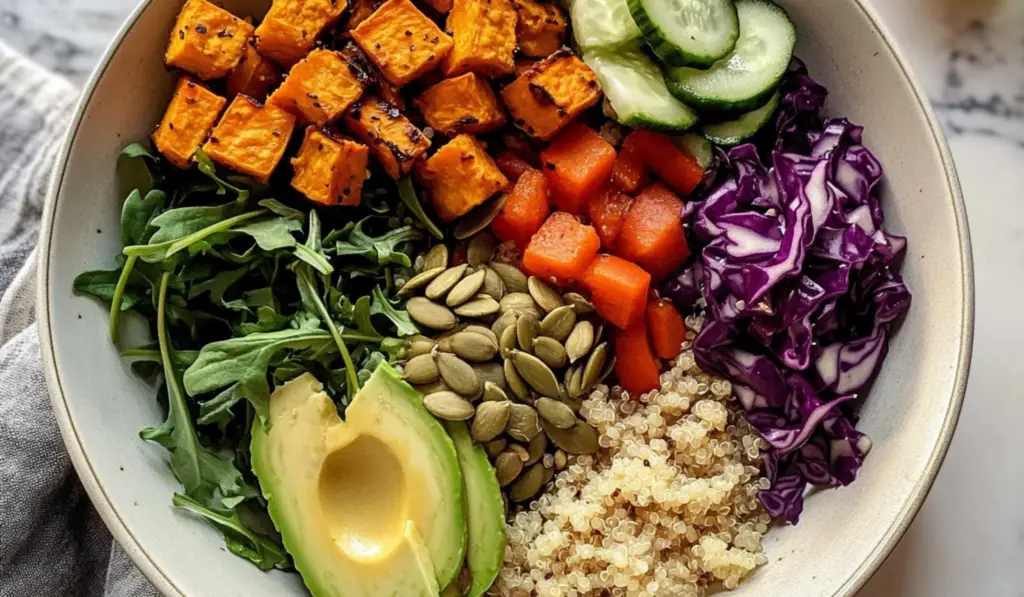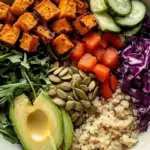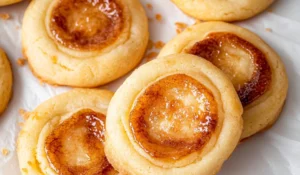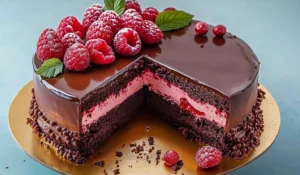The Buddha Bowl is a culinary masterpiece that has earned a well-deserved place in the hearts of food lovers everywhere. Combining a balance of wholesome ingredients, vibrant colors, and a variety of flavors and textures, this dish is more than just a meal—it’s an experience. The Buddha Bowl, also known as a grain bowl or power bowl, is a great way to enjoy a nourishing, satisfying meal while incorporating a wide range of nutrient-rich ingredients.
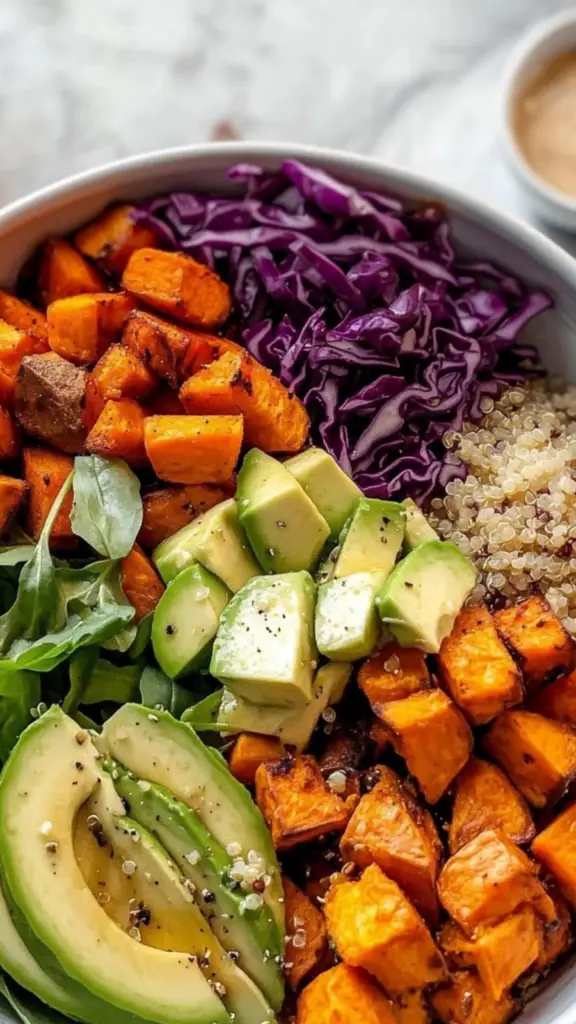
The Ultimate Buddha Bowl: A Wholesome Vegan Delight
The Buddha Bowl is a culinary masterpiece that has earned a well-deserved place in the hearts of food lovers everywhere. Combining a balance of wholesome ingredients, vibrant colors, and a variety of flavors and textures, this dish is more than just a meal—it’s an experience. The Buddha Bowl, also known as a grain bowl or power bowl, is a great way to enjoy a nourishing, satisfying meal while incorporating a wide range of nutrient-rich ingredients.
- Prep Time: 15 minutes
- Cook Time: 55 minutes
- Total Time: 1 hour 10 minutes
- Yield: 4 servings 1x
- Category: Vegan, Salad, Grain Bowl, Meal Prep
- Method: Roasting, Boiling
- Cuisine: American, Vegan
- Diet: Vegan
Ingredients
For the Sweet Potatoes:
Sweet potatoes are the star of this Buddha Bowl. Their natural sweetness adds a comforting, earthy flavor that pairs beautifully with the other ingredients. Roasting them enhances their sweetness and caramelizes the edges, creating a crispy, golden exterior and a tender interior.
- 2 medium sweet potatoes: Cut into 1-inch cubes. Sweet potatoes are a great source of vitamins A and C, fiber, and antioxidants. Their vibrant orange color is a sign of their high beta-carotene content, which supports healthy vision and skin.
- 2 tablespoons olive oil: Used to coat the sweet potatoes, olive oil adds richness and helps with roasting.
- ¼ teaspoon Italian seasoning: Adds a blend of herbs, such as oregano, basil, and thyme, for a savory flavor profile.
- ½ teaspoon salt and ¼ teaspoon ground black pepper: Essential for enhancing the natural flavors of the sweet potatoes.
For the Quinoa:
Quinoa serves as the base of the Buddha Bowl, providing a nutrient-dense source of protein, fiber, and essential amino acids. It’s an excellent option for vegetarians and vegans looking to add more plant-based protein to their diet.
- ½ cup quinoa (uncooked): Quinoa is a whole grain that has a nutty flavor and a slightly chewy texture. It’s also gluten-free, making it suitable for those with gluten sensitivities.
- ¾ cup water: Used to cook the quinoa, creating a fluffy and light texture.
- ½ teaspoon olive oil: Helps prevent the quinoa from sticking and adds a touch of richness.
For the Buddha Bowl Base:
The base of this Buddha Bowl is made up of fresh vegetables and greens. These ingredients provide crunch, color, and a variety of vitamins and minerals that support overall health.
- ½ cup arugula or baby spinach: Arugula has a peppery flavor that complements the sweetness of the roasted sweet potatoes, while spinach offers a mild, earthy flavor.
- 1 red bell pepper, diced: Adds a pop of color and a sweet, crisp bite to the bowl.
- 1 large English cucumber, diced: Provides a refreshing, hydrating crunch that balances the other ingredients.
- 1 cup purple cabbage, chopped: Adds vibrant color and a crunchy texture, along with a mild, slightly sweet flavor.
- 1 medium avocado, thinly sliced: The creamy texture of avocado is a welcome contrast to the crunchiness of the other ingredients.
- ¼ cup pumpkin seeds: A perfect finishing touch, these seeds add a delightful crunch and a boost of healthy fats and protein.
For the Dressing:
The Dijon vinaigrette is the perfect complement to the Buddha Bowl, adding tang, sweetness, and a touch of sharpness. It ties all the ingredients together and brings an extra layer of flavor to the dish.
- 3 tablespoons balsamic vinegar: Provides a tangy base for the dressing, with a slightly sweet and acidic flavor.
- 2 tablespoons olive oil: Balances the acidity of the vinegar and creates a smooth dressing.
- 1 teaspoon Dijon mustard: Adds a sharp, tangy kick to the vinaigrette.
- 1 teaspoon maple syrup or honey: Sweetens the dressing slightly, balancing the tanginess.
- ¼ teaspoon salt and ¼ teaspoon ground black pepper: Essential for bringing out the flavors in the dressing.
Instructions
Step 1: Roast the Sweet Potatoes
Preheat your oven to 400°F (200°C). While the oven is heating up, chop the sweet potatoes into 1-inch cubes. Place the sweet potatoes on a large baking sheet, drizzle with olive oil, and sprinkle with Italian seasoning, salt, and pepper. Toss the sweet potatoes to coat them evenly with the seasoning. Spread them out in a single layer on the baking sheet, ensuring that they are not crowded.
Roast the sweet potatoes for 35–40 minutes, or until they are tender and golden brown. Stir halfway through the cooking time to ensure even roasting. If you prefer extra crispy sweet potatoes, you can broil them on high for 2–3 minutes at the end. Once done, set the sweet potatoes aside.
Step 2: Cook the Quinoa
While the sweet potatoes are roasting, rinse the quinoa under cold running water for about a minute to remove any bitterness. Drain the quinoa well and transfer it to a medium pot. Add the water and olive oil, and bring to a boil over medium heat. Once boiling, cover the pot, reduce the heat to low, and let the quinoa simmer for 15 minutes. After 15 minutes, the water should be absorbed, and the quinoa should be tender. Remove the pot from heat and let it sit, covered, for another 5 minutes. Fluff the quinoa with a fork to separate the grains.
Step 3: Assemble the Buddha Bowl
In a large serving bowl, start with a generous layer of quinoa as the base. Arrange the roasted sweet potatoes, arugula (or spinach), red bell pepper, cucumber, purple cabbage, and avocado in sections on top of the quinoa. Sprinkle the pumpkin seeds over the top for added crunch.
Step 4: Prepare the Dressing
In a small bowl, whisk together the balsamic vinegar, olive oil, Dijon mustard, maple syrup (or honey), salt, and pepper until the dressing is smooth and emulsified.
Step 5: Drizzle and Serve
Drizzle the dressing over the Buddha Bowl just before serving. Toss gently if desired or leave the ingredients arranged in sections for a visually appealing presentation. Serve immediately, and enjoy the harmony of flavors and textures in each bite.
Notes
- Protein Boost: Add some grilled tofu, chickpeas, or tempeh for a plant-based protein boost.
- Grain Swap: Try using farro, brown rice, or couscous instead of quinoa for a different texture and flavor.
- Greens Variety: If you’re not a fan of arugula or spinach, try kale, romaine lettuce, or mixed greens for a fresh, leafy base.
- Sweet Potato Variations: If you’re not a fan of sweet potatoes, try roasted butternut squash or carrots for a different flavor profile.
- Toppings: Add other toppings like roasted nuts, crumbled feta, or sprouts for added texture and flavor.
This recipe is a vegan Buddha Bowl, with roasted sweet potatoes, hearty quinoa, fresh vegetables, creamy avocado, and crunchy pumpkin seeds, all topped with a tangy homemade Dijon vinaigrette. It’s perfect for those looking for a quick yet nourishing meal that can be customized to suit their preferences and dietary needs. Whether you’re preparing it for lunch, dinner, or meal prep, this bowl is a true crowd-pleaser that brings together the best of what plant-based eating has to offer.
Let’s take a deep dive into the components of this recipe and explore how they come together to create a delicious and nourishing meal. From the roasted sweet potatoes to the quinoa and fresh vegetables, every ingredient in this Buddha Bowl plays a unique role in making it a satisfying and well-rounded dish.
The Components of the Buddha Bowl
The beauty of the Buddha Bowl lies in its versatility. While there are some key ingredients that form the backbone of the recipe, such as roasted vegetables, quinoa, and fresh greens, you can swap out and customize the ingredients based on what’s in season, what you have on hand, or your personal preferences. The key is to create a balance between the flavors, textures, and nutrients in each bite.
In this recipe, we use roasted sweet potatoes, quinoa, fresh arugula, red bell pepper, cucumber, purple cabbage, and avocado. These ingredients combine to create a harmonious blend of flavors, from the sweetness of the roasted sweet potatoes to the nuttiness of the quinoa, the crunch of the vegetables, and the creaminess of the avocado. But it’s not just about the flavors—it’s also about the textures. The roasted sweet potatoes bring a satisfying softness, while the quinoa adds a light, fluffy texture. The vegetables and pumpkin seeds provide a satisfying crunch, and the avocado lends a creamy richness that ties everything together.
But perhaps the most important element of the Buddha Bowl is the dressing. A good dressing can take any salad or grain bowl from good to great, and this Dijon vinaigrette is the perfect complement to the dish. It’s tangy, slightly sweet, and just the right amount of zesty. When drizzled over the bowl, it enhances the flavors of the ingredients and brings the entire dish together in a delightful way.
Ingredients Breakdown
Let’s break down the ingredients that make up this Buddha Bowl, starting with the roasted sweet potatoes.
For the Sweet Potatoes:
Sweet potatoes are the star of this Buddha Bowl. Their natural sweetness adds a comforting, earthy flavor that pairs beautifully with the other ingredients. Roasting them enhances their sweetness and caramelizes the edges, creating a crispy, golden exterior and a tender interior.
- 2 medium sweet potatoes: Cut into 1-inch cubes. Sweet potatoes are a great source of vitamins A and C, fiber, and antioxidants. Their vibrant orange color is a sign of their high beta-carotene content, which supports healthy vision and skin.
- 2 tablespoons olive oil: Used to coat the sweet potatoes, olive oil adds richness and helps with roasting.
- ¼ teaspoon Italian seasoning: Adds a blend of herbs, such as oregano, basil, and thyme, for a savory flavor profile.
- ½ teaspoon salt and ¼ teaspoon ground black pepper: Essential for enhancing the natural flavors of the sweet potatoes.
For the Quinoa:
Quinoa serves as the base of the Buddha Bowl, providing a nutrient-dense source of protein, fiber, and essential amino acids. It’s an excellent option for vegetarians and vegans looking to add more plant-based protein to their diet.
- ½ cup quinoa (uncooked): Quinoa is a whole grain that has a nutty flavor and a slightly chewy texture. It’s also gluten-free, making it suitable for those with gluten sensitivities.
- ¾ cup water: Used to cook the quinoa, creating a fluffy and light texture.
- ½ teaspoon olive oil: Helps prevent the quinoa from sticking and adds a touch of richness.
For the Buddha Bowl Base:
The base of this Buddha Bowl is made up of fresh vegetables and greens. These ingredients provide crunch, color, and a variety of vitamins and minerals that support overall health.
- ½ cup arugula or baby spinach: Arugula has a peppery flavor that complements the sweetness of the roasted sweet potatoes, while spinach offers a mild, earthy flavor.
- 1 red bell pepper, diced: Adds a pop of color and a sweet, crisp bite to the bowl.
- 1 large English cucumber, diced: Provides a refreshing, hydrating crunch that balances the other ingredients.
- 1 cup purple cabbage, chopped: Adds vibrant color and a crunchy texture, along with a mild, slightly sweet flavor.
- 1 medium avocado, thinly sliced: The creamy texture of avocado is a welcome contrast to the crunchiness of the other ingredients.
- ¼ cup pumpkin seeds: A perfect finishing touch, these seeds add a delightful crunch and a boost of healthy fats and protein.
For the Dressing:
The Dijon vinaigrette is the perfect complement to the Buddha Bowl, adding tang, sweetness, and a touch of sharpness. It ties all the ingredients together and brings an extra layer of flavor to the dish.
- 3 tablespoons balsamic vinegar: Provides a tangy base for the dressing, with a slightly sweet and acidic flavor.
- 2 tablespoons olive oil: Balances the acidity of the vinegar and creates a smooth dressing.
- 1 teaspoon Dijon mustard: Adds a sharp, tangy kick to the vinaigrette.
- 1 teaspoon maple syrup or honey: Sweetens the dressing slightly, balancing the tanginess.
- ¼ teaspoon salt and ¼ teaspoon ground black pepper: Essential for bringing out the flavors in the dressing.
Step-by-Step Instructions
Now that we’ve covered the ingredients, let’s walk through the process of making this Buddha Bowl. It’s a simple, straightforward recipe that comes together in just over an hour.
Step 1: Roast the Sweet Potatoes
Preheat your oven to 400°F (200°C). While the oven is heating up, chop the sweet potatoes into 1-inch cubes. Place the sweet potatoes on a large baking sheet, drizzle with olive oil, and sprinkle with Italian seasoning, salt, and pepper. Toss the sweet potatoes to coat them evenly with the seasoning. Spread them out in a single layer on the baking sheet, ensuring that they are not crowded.
Roast the sweet potatoes for 35–40 minutes, or until they are tender and golden brown. Stir halfway through the cooking time to ensure even roasting. If you prefer extra crispy sweet potatoes, you can broil them on high for 2–3 minutes at the end. Once done, set the sweet potatoes aside.
Step 2: Cook the Quinoa
While the sweet potatoes are roasting, rinse the quinoa under cold running water for about a minute to remove any bitterness. Drain the quinoa well and transfer it to a medium pot. Add the water and olive oil, and bring to a boil over medium heat. Once boiling, cover the pot, reduce the heat to low, and let the quinoa simmer for 15 minutes. After 15 minutes, the water should be absorbed, and the quinoa should be tender. Remove the pot from heat and let it sit, covered, for another 5 minutes. Fluff the quinoa with a fork to separate the grains.
Step 3: Assemble the Buddha Bowl
In a large serving bowl, start with a generous layer of quinoa as the base. Arrange the roasted sweet potatoes, arugula (or spinach), red bell pepper, cucumber, purple cabbage, and avocado in sections on top of the quinoa. Sprinkle the pumpkin seeds over the top for added crunch.
Step 4: Prepare the Dressing
In a small bowl, whisk together the balsamic vinegar, olive oil, Dijon mustard, maple syrup (or honey), salt, and pepper until the dressing is smooth and emulsified.
Step 5: Drizzle and Serve
Drizzle the dressing over the Buddha Bowl just before serving. Toss gently if desired or leave the ingredients arranged in sections for a visually appealing presentation. Serve immediately, and enjoy the harmony of flavors and textures in each bite.
Flavors, Textures, and Aromas
The beauty of the Buddha Bowl lies in its balanced combination of flavors and textures. The roasted sweet potatoes add a comforting sweetness, complemented by the earthy quinoa and the crisp, fresh vegetables. The avocado provides a creamy richness that ties the whole bowl together, while the pumpkin seeds offer a satisfying crunch. The dressing is the final touch, with its tangy balsamic vinegar, sharp Dijon mustard, and just the right amount of sweetness from the maple syrup. Together, these ingredients create a bowl that is as nourishing as it is delicious.
Tips for Substitutions and Variations
- Protein Boost: Add some grilled tofu, chickpeas, or tempeh for a plant-based protein boost.
- Grain Swap: Try using farro, brown rice, or couscous instead of quinoa for a different texture and flavor.
- Greens Variety: If you’re not a fan of arugula or spinach, try kale, romaine lettuce, or mixed greens for a fresh, leafy base.
- Sweet Potato Variations: If you’re not a fan of sweet potatoes, try roasted butternut squash or carrots for a different flavor profile.
- Toppings: Add other toppings like roasted nuts, crumbled feta, or sprouts for added texture and flavor.
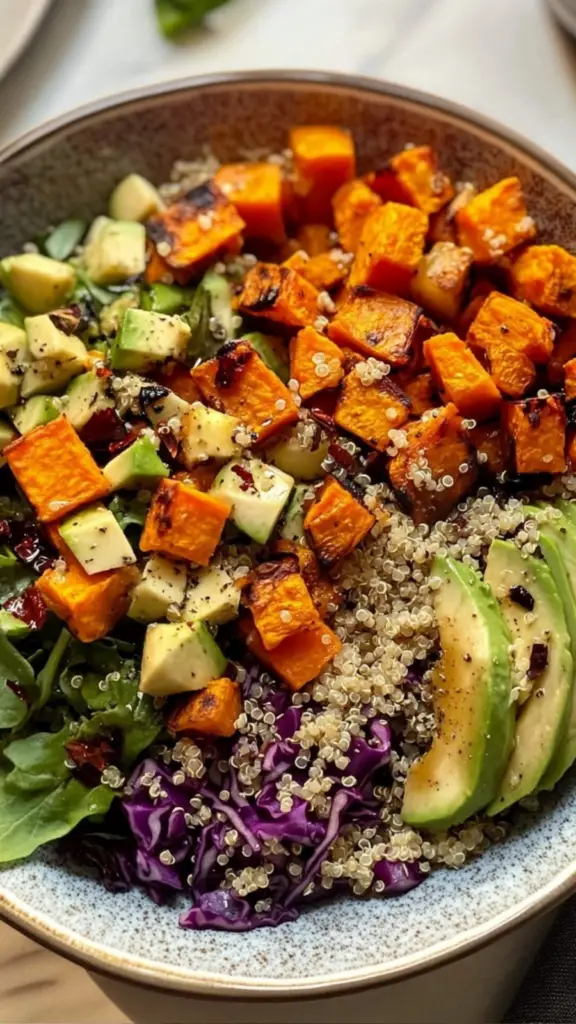
Serving Suggestions
This Buddha Bowl is a complete meal on its own, but you can pair it with a side of crusty bread, a light soup, or fresh fruit for a more rounded dining experience. You can also serve it as part of a larger spread for a family-style meal. For meal prep, store the components separately and assemble the bowls just before eating. This will ensure that everything stays fresh and crisp.
Conclusion
The Buddha Bowl is a dish that is as nourishing for the body as it is for the soul. With its balance of flavors, colors, and textures, it’s a meal that satisfies both the stomach and the senses. Whether you’re looking for a quick weeknight dinner, a meal prep solution, or a healthy lunch option, this vegan Buddha Bowl is sure to become a favorite in your kitchen. Enjoy experimenting with different ingredients and toppings to make it your own, and most importantly, enjoy the process of nourishing yourself with wholesome, delicious food.
